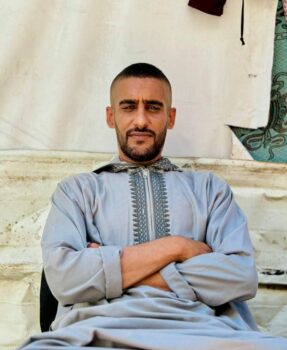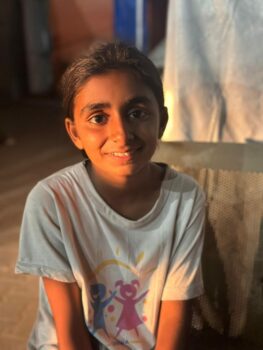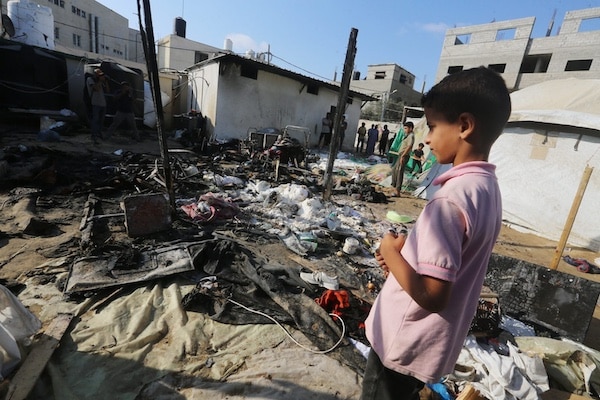On Sunday, August 4, around 2 a.m., the Israeli army bombed a group of tents inside the compound of the Al-Aqsa Martyrs Hospital in Deir al-Balah, in central Gaza. The bombing led to the death of three people and the injury of dozens, according to the Gaza Ministry of Health.
Nahed Saleh, 36, is displaced from Beit Hanoun in the northern Gaza Strip. She was sleeping when the bombing occurred a few meters away from her tent inside the courtyard of the Al-Aqsa Martyrs Hospital. She left the tent to find people running everywhere, screaming and crying. In a terrifying scene, she saw a cluster of tents nearby set ablaze by the bombs.
“At two o’clock, we woke up to a huge explosion. We heard the voices of people screaming, asking, and calling for help to put out the fires. Suddenly, while we were sleeping, the bombing and the raging fire surprised us. People were in the middle of the fire. Saleh told Mondoweiss.
“We didn’t know where to go or how to move. The intensity of the explosion made us leave the tents without putting on our clothes. We were wearing our nightclothes. We thought the bombing was targeting the entire hospital. We went out to find the fire burning the tents next to ours,” she continued.
“It was a nightmare I haven’t woken up from yet. The size of the fire was terrifying, and there was no one to put it out. After a while, the firefighters came, and we saw them taking out the completely burned bodies. The scene was horrific. No one could comprehend it. We saw charred victims with no features,” Saleh said.
It was a real terror that we lived, and we live it every day in this war.
The bombing on Sunday was not the first time that the Israeli army has targeted the tents of the displaced people in Gaza. Just last month, an Israeli airstrike targeted tents housing displaced Palestinains in the al-Mawasi area outside of Khan Younis in southern Gaza, killing 90 people. Two weeks ago, an Israeli strike targeted a tent housing journalists inside the courtyard of the Al-Aqsa Martyrs hospital, killing one person.
Fadi Thabet, a journalist and photographer who is living in the rebuilt journalists’ tent on the hospital grounds, was near the place that was targeted when the bomb was dropped. After hearing the explosion, he left his tent to document what was happening. As soon as he left his tent, he saw flames rising from the tents nearby.
“We realized that a drone targeted some tents, and the surrounding tents caught fire. We arrived at the place immediately and began documenting a heinous crime against civilians sleeping in their tents inside the hospital, which is a place that is supposed to be safe and internationally protected,” he said.
“Civilians started rushing to the place to put out the fires, but the fire continued to burn for about 20 minutes in the tents. Once the fire was put out, the paramedics started pulling out martyrs and the injured from the place. The scenes were difficult and harsh,” Fadi said from inside the hospital, surrounded by the remains of scorched tents.
They pulled out charred bodies due to the fire, in addition to bodies that were in pieces.

GHALEB AL-AWINI
After the bombing, scenes of chaos erupted in the courtyard of the hospital, as people began running frantically to check on their families.
Samah Al-Nazli, 34, was less than 10 meters away from the bombed tent. She is almost unable to narrate what she saw until this moment, three days after the crime. She says with great difficulty that she did not hear anything during the bombing but felt the fire and then the explosion, and that those moments were the most terrifying in her entire life.
“Out of fear, I grabbed my three daughters and ran out of the hospital without knowing where to go. The fire torched more than seven tents, and my friend was martyred, leaving two innocent children behind,” she told Mondoweiss.
“All I saw was destruction and fire. I saw three young men and a girl completely burned, and my relatives in the neighboring tent suffered minor burns. The shrapnel reached them. We left everything behind us and ran to escape,” she recounted.
“I thought my three daughters and I were dead when I heard the bombing this time,” said al-Nazli, noting that her family was close to the journalists’ tent that was bombed a few weeks prior. “Because the previous time, the bombing was close to us too. How can we find safety or feel safe?,” she asked.
Ghaleb Al-Awini, 24, a nurse who has been working as a volunteer in the reception and emergency department at Al-Aqsa Martyrs Hospital since October 7, was at the entrance to the department when the explosion occurred, a few meters away from the tent that the Israeli army had bombed.
“People were sleeping in their tents, and suddenly, when the bombing happened, everyone started running because of the huge explosion we heard. When we reached the burning tents to rescue people, we started pulling out the victims. The first victim was a woman suffering from head bleeding, and she later passed away,” al-Awini recounted.
“We used simple tools, such as water and fire extinguishers, to put out the fire. The fire was huge and the firefighting crews were unable to put it out easily. Some of the paramedics suffered from suffocation due to the gas emitted by the toxic materials from the missiles,” he said.
There were more than 17 injured women and children, and there was a martyr who was a volunteer from the hospital security staff. Because of the fire, the bodies of the martyrs were burned.

HALIMA OMAR
Al-Awini, who has been working in the hospital since the beginning of the war and has seen countless cases of victims of Israeli bombings being carried into the hospital, pointed out that these scenes were brutal.
The pain is great, the fire was huge, I have never seen people so scared before, and I have never seen victims like this before, completely burned; it is painful to see these scenes.
Next to her tent inside the Al-Aqsa Martyrs Hospital, sits Halima Omar, a 9-year-old girl who was displaced from Gaza City and had no choice but to stay in this terrifying environment.
In her testimony, she says that she does not know how she will forget the scene of the flames burning the bodies of the martyrs and how she will forget the image of the charred martyrs that she saw with her own eyes.
“The martyrs were cut up and burned; no one knew how to carry them; I saw martyrs cut up, many martyrs,” the young child told Mondoweiss.
I do not want to see all this; I am still a child; this is too much; I want to return to Gaza City and my school.
Mahmoud Abu Humdah conducted the interviews for this report from Gaza.
Tareq S. Hajjaj is the Mondoweiss Gaza Correspondent, and a member of the Palestinian Writers Union. He studied English Literature at Al-Azhar University in Gaza. He started his career in journalism in 2015 working as a news writer and translator for the local newspaper, Donia al-Watan. He has reported for Elbadi, Middle East Eye, and Al Monitor.

